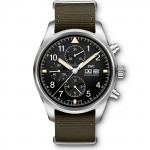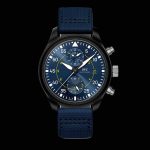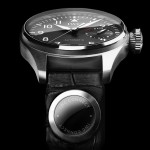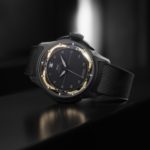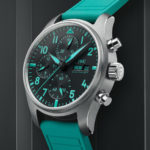A Brief History of the IWC Pilot’s Watch
From the "Mark" series to the Big Pilot's Watch.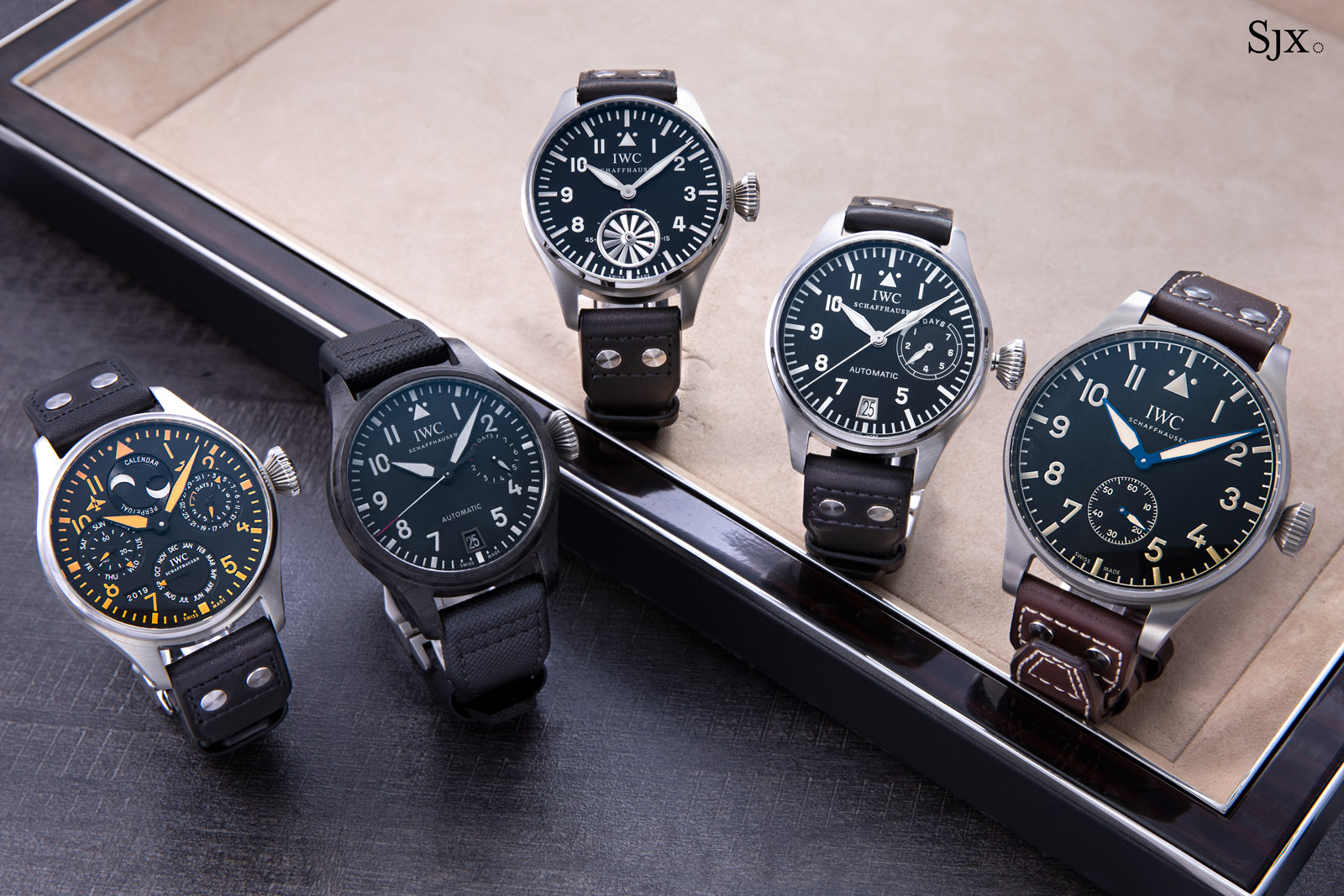
One of IWC’s signature wristwatch lines – the other being the Portugieser – is the Pilot’s Watch, a collection descended from the timepieces dating to the earliest days of aviation.
Popular for its functional styling and general affordability, the Pilot’s Watch collection is regularly updated – IWC revamped the range in 2016, 2019, and again this year – and diverse.
There are two threads running through IWC’s modern-day Pilot’s Watch collection that connect to the brand’s historical aviator’s watches: the smaller “Mark” watches typically associated with the British Royal Air Force (RAF) and the oversized “B-Uhr” made for the German air force of the Second World War.
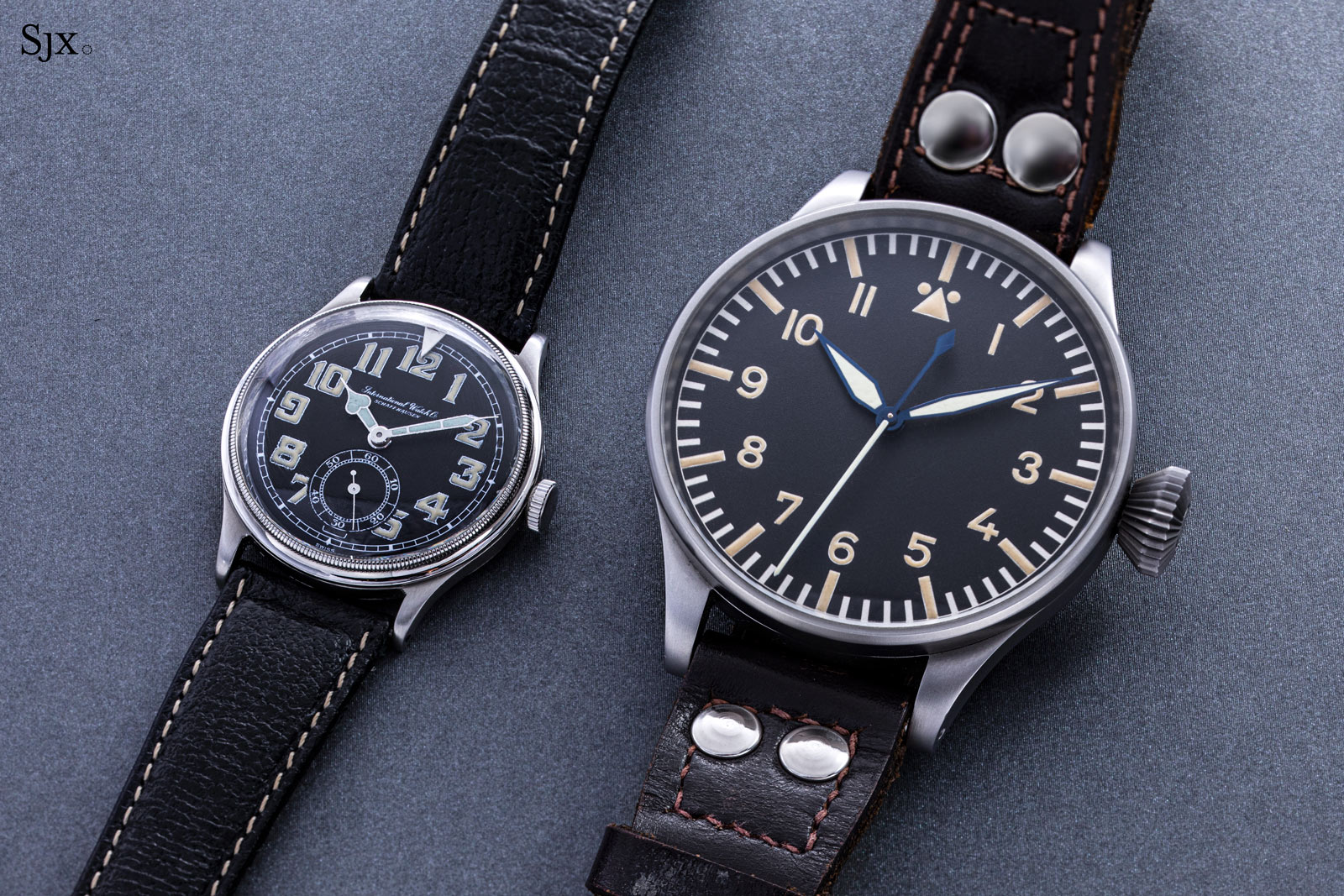
Big pilot and small pilot – Mark IX and B-uhr
The origins
IWC’s history in aviator’s watches started the Special Pilot’s Watch ref. 436, now widely known as the “Mark IX”. Conceived by the two sons of Ernst Jakob Homberger, the then-owner of IWC, the Mark IX was unveiled in 1936.
Homberger’s sons were both licensed pilots and understood the features required for good pilot’s watch, resulting in style that is now synonymous with the pilot’s watch genre. IWC was not the only maker of pilot’s watches during the period, though it was arguably the most successful since it continued to be a leading supplier of aviator’s timepieces for the next two decades.
The Mark IX had a 38 mm case – extraordinarily oversized in an era when the standard man’s watch was about 30 mm – along with an equally large, legible dial, along with an antimagnetic movement that was able to keep decent time from -40 °C and +40 °C.
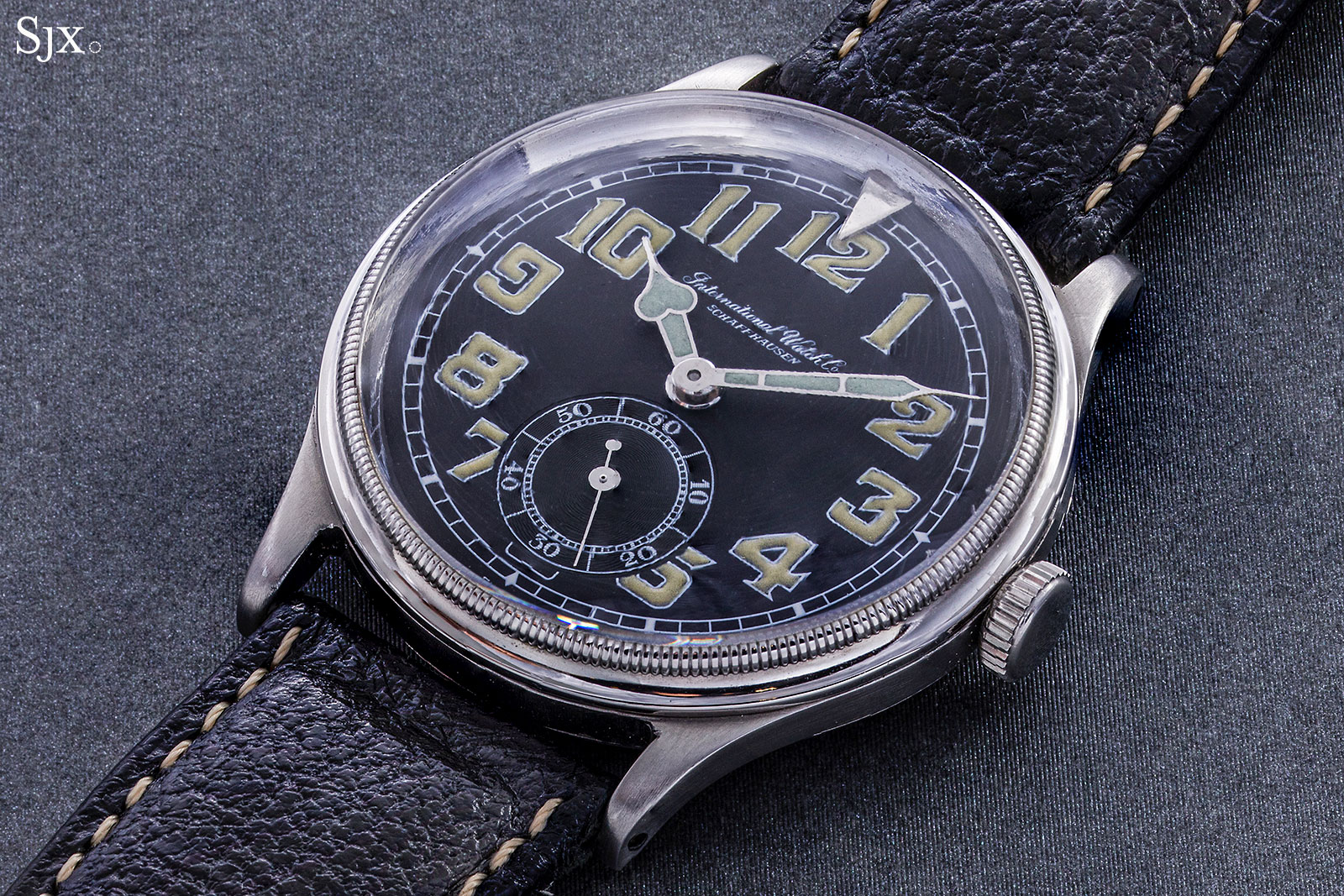
The Mark IX with its inner rotating bezel to measure elapsed time
The “Mark IX” moniker was never the formal name for the ref. 436, instead it only came about because of the subsequently Mark 11, perhaps IWC’s most famous vintage pilot’s watch. (In between the two was the model known as the “Mark X”, which was issued to British troops during the Second World War.)
Produced from 1948 onwards for the RAF, the IWC Mark 11 was a high-spec, precision wristwatch for aviators powered by the chronometer-grade cal. 89. The Mark 11 was such a good performer the RAF kept it in service until 1984 – some four decades.
IWC was the primary supplier of the watch, although Jaeger-LeCoultre also supplied a smaller number of them. Notably, Omega also supplied a similar looking, but lower spec, wristwatch, the ref. 2777 or “53”.
With its central seconds and sans-serif Arabic numerals, the Mark 11 became the template for the modern-day IWC Pilot’s Watch.
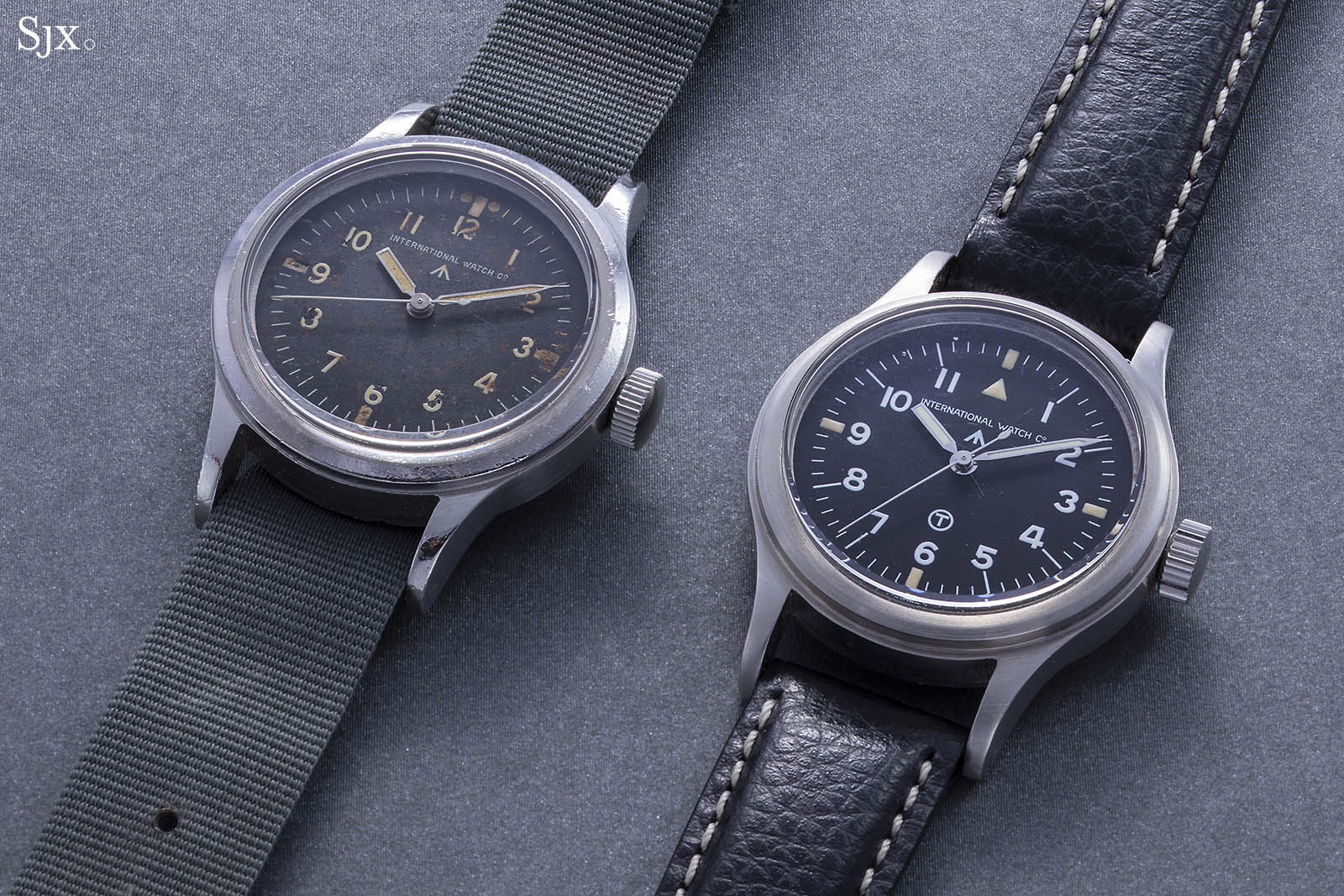
Two versions of the Mark 11, an earlier example (left), and later example with a triangle at 12
The big one
The second strand that connects today’s Pilot’s Watch to IWC’s history starts in 1940 with the Luftwaffe, the German air force of the second world war. That year, IWC became one of the five suppliers of the beobachtungsuhr, or “B-uhr” for short (and “B-uhren” in plural).
The name translates literally as “observer’s watch”, but the B-uhr is more correctly known as a navigator’s watch. Designed according to air force ministry specification Fl. 23883, the B-uhren were oversized, 55 mm watches equipped with pocket watch movements.
Two dial styles were specified for the B-uhren, first a version with only Arabic hours numerals around the dial known as Baumuster A, which was later replaced in 1941 by one with a five-minute track on on outer scale, and hour numbers on an inner scale known as Baumuster B.
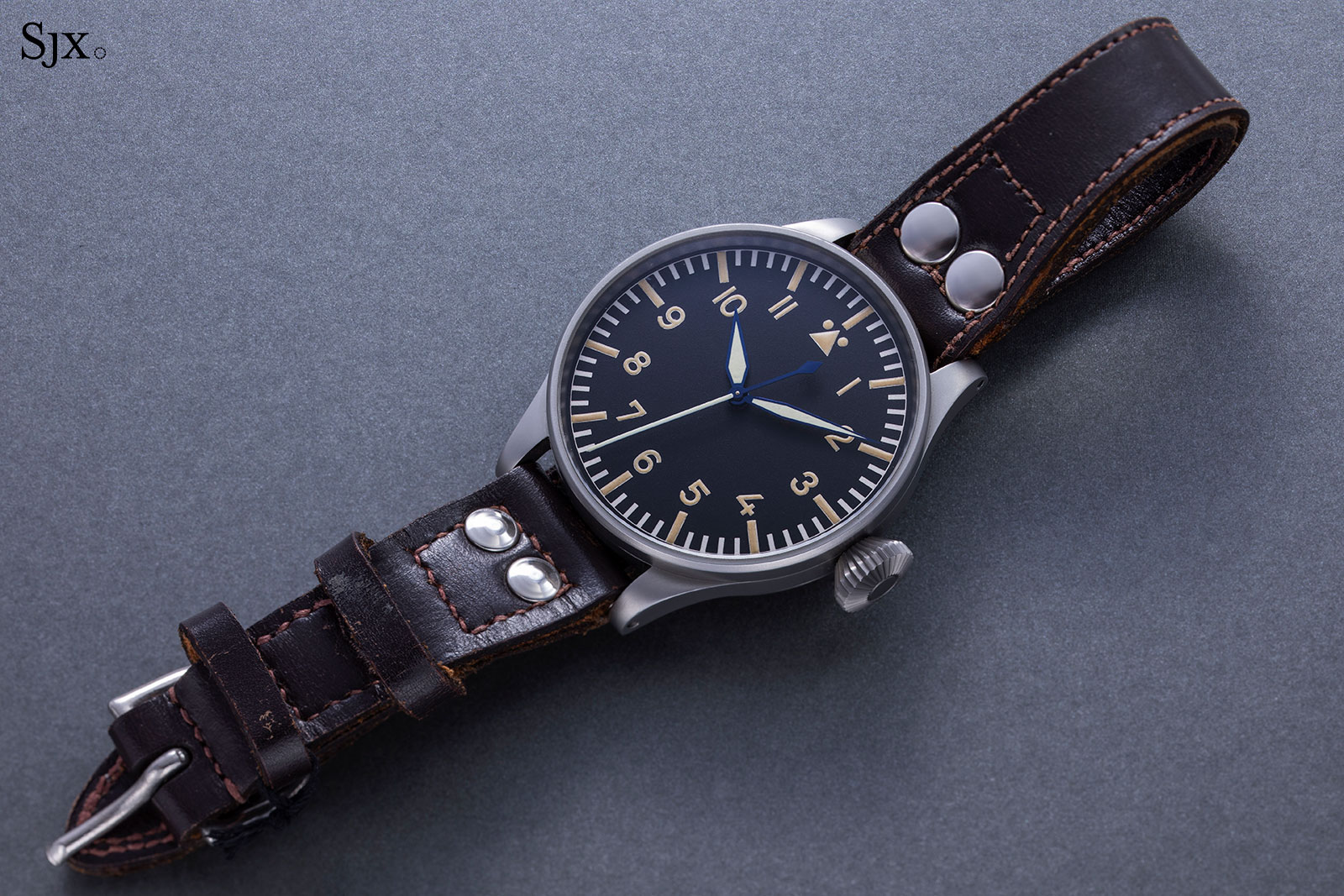
The crisp ref. 431 from the IWC Museum
IWC, however, only produced B-uhren with “Type A” dials for the Luftwaffe. According to military watch scholar Konrad Knirim, author of reference book German Military Timepieces, IWC delivered 1,000 examples of the B-uhr to the Luftwaffe in 1940.
The IWC B-uhren were all powered by the cal. 52 T.S.C, a pocket watch movement modified to have an indirectly-driven central seconds. Notably, since IWC had produced 1,200 of the cal. 52 T.S.C. movements, the balance of 200 went into deck chronometer watches for the British Royal Navy.
Having the model reference 431, the watch was nicknamed the “Grosse Fliegeruhr”, or “big pilot’s watch”, making it quite literally the first Big Pilot’s Watch.
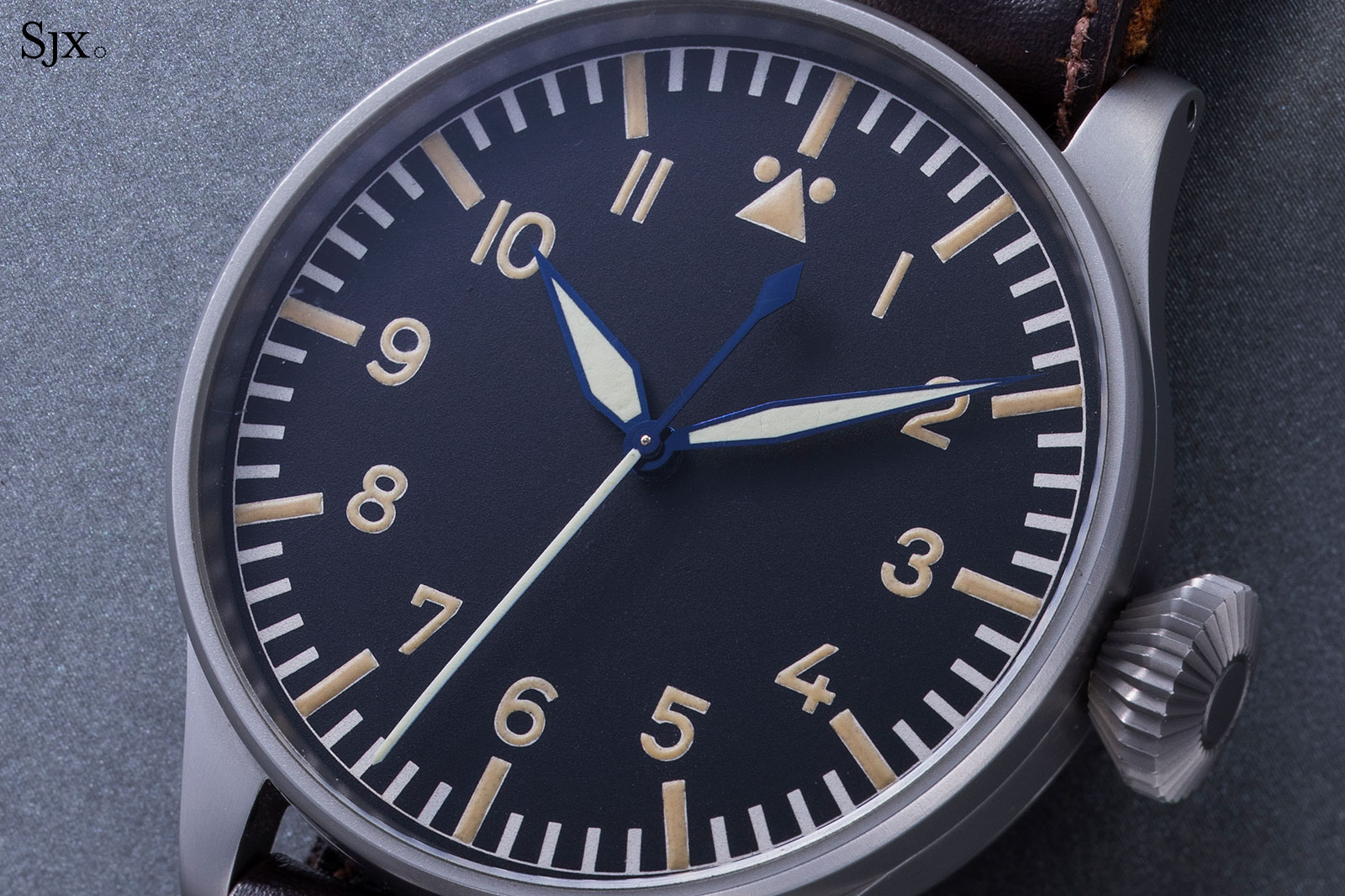
The Baumuster A dial of the IWC B-uhr
A 21st century return
With the introduction of the Mark 12 in 1994, IWC once again starting making pilot’s watches, all taking inspiration from the Mark 11. But the Grosse Fliegeruhr remained a historical artefact until after the turn of millennium, when the Big Pilot’s Watch ref. 500201 (usually known as the ref. 5002) made its debut at the Baselworld 2002.
The revival of the B-uhr was first mooted by the late Gunter Blümlein, the then-chief of IWC who also helped revive A. Lange & Söhne, though he passed away in late 2001, shortly before the ref. 5002 made it to market.
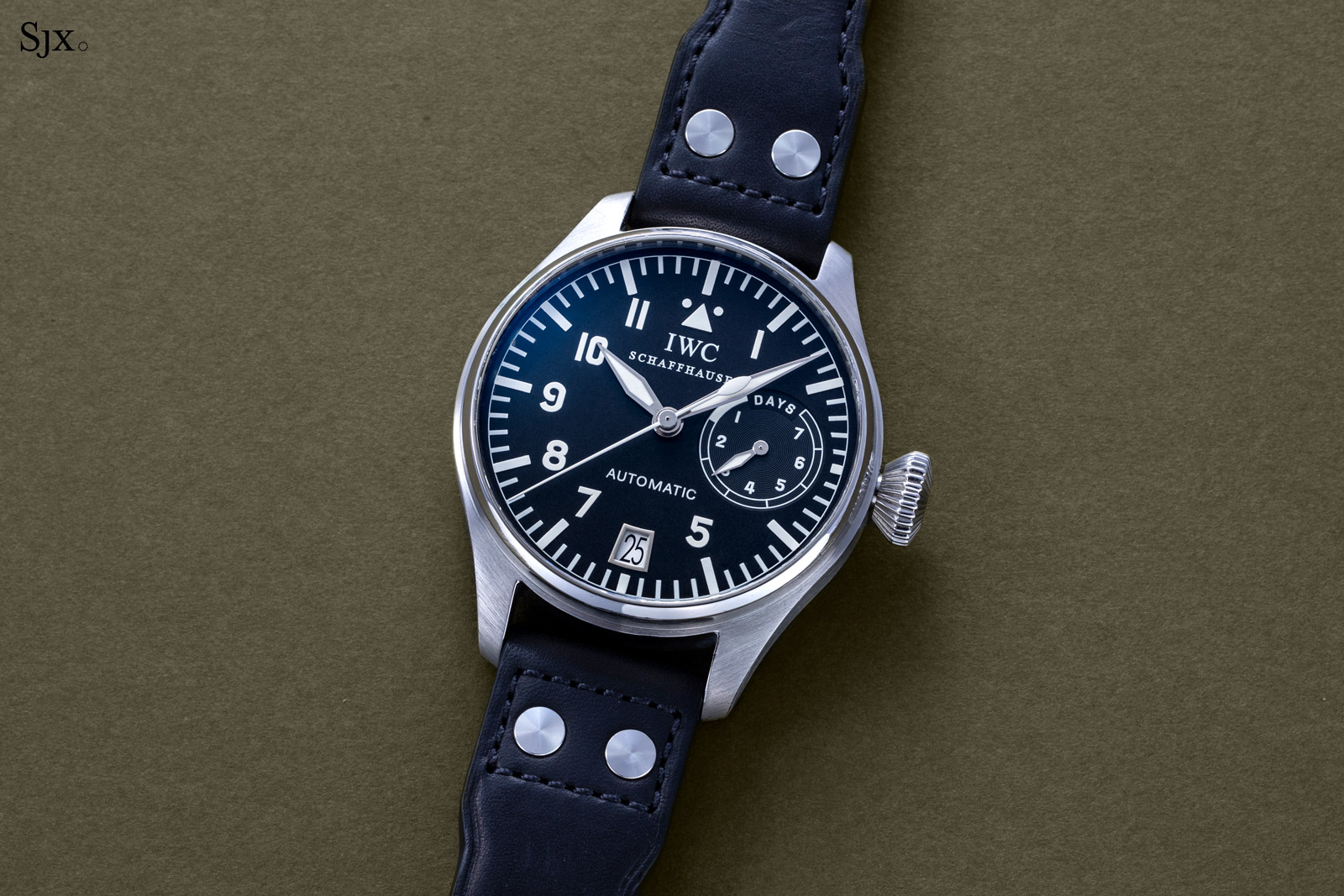
The ref. 5002
Codenamed “Mark XXI” when it was in development, “Big Pilot” soon became an IWC trademark – legally and figuratively – growing into a line of aviator’s watches on its own, distinct from those descended from the Mark 11.
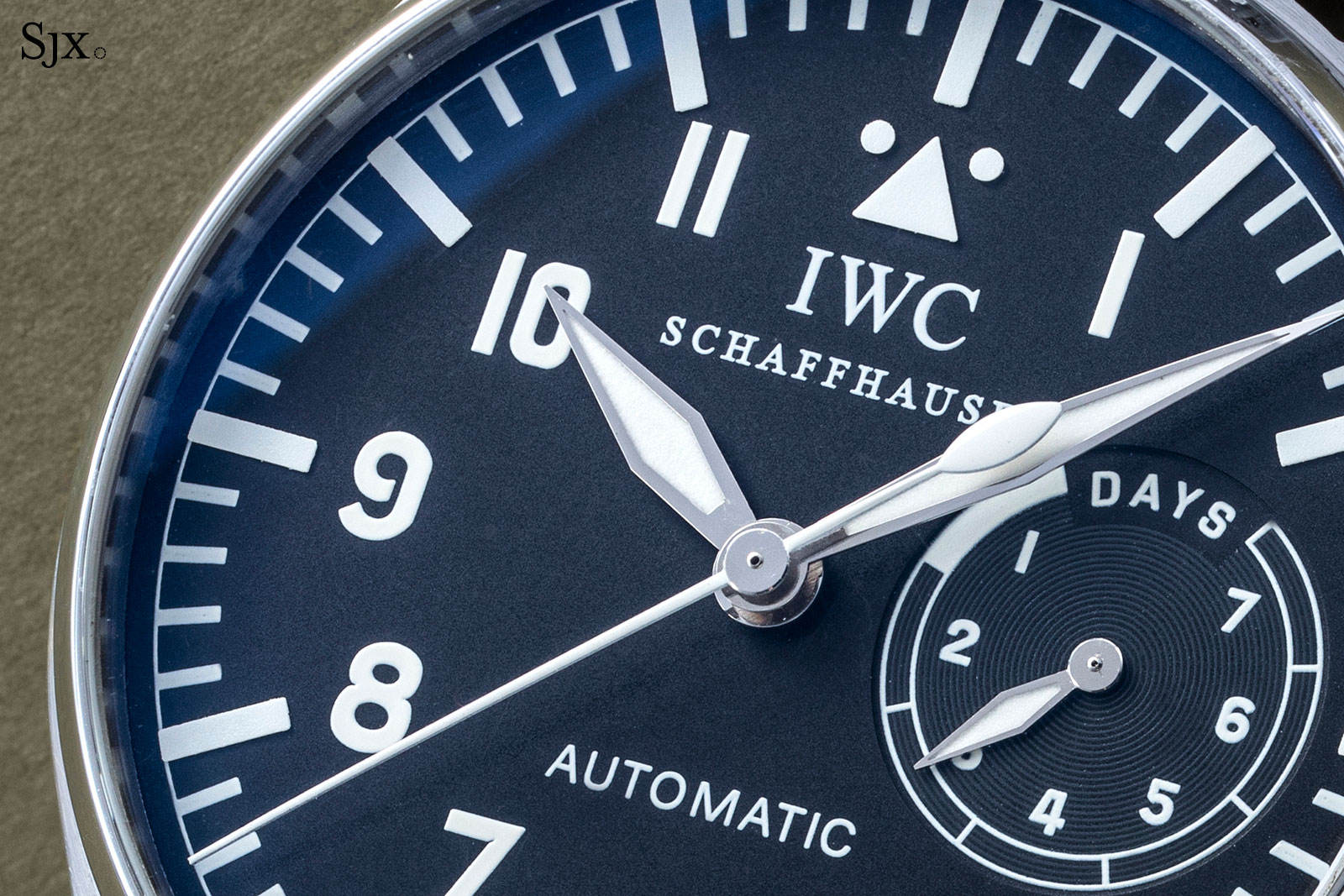
The modern-day B-uhr
Historically significant in being the first Big Pilot’s Watch since 1940, the ref. 5002 set the tone for all subsequent models, both aesthetically and mechanically.
Like many of the best vintage remakes of today, the ref. 5002 preserved the key details of the B-uhr, like the unusual 12 o’clock marker and “onion” crown, while refining the overall design.
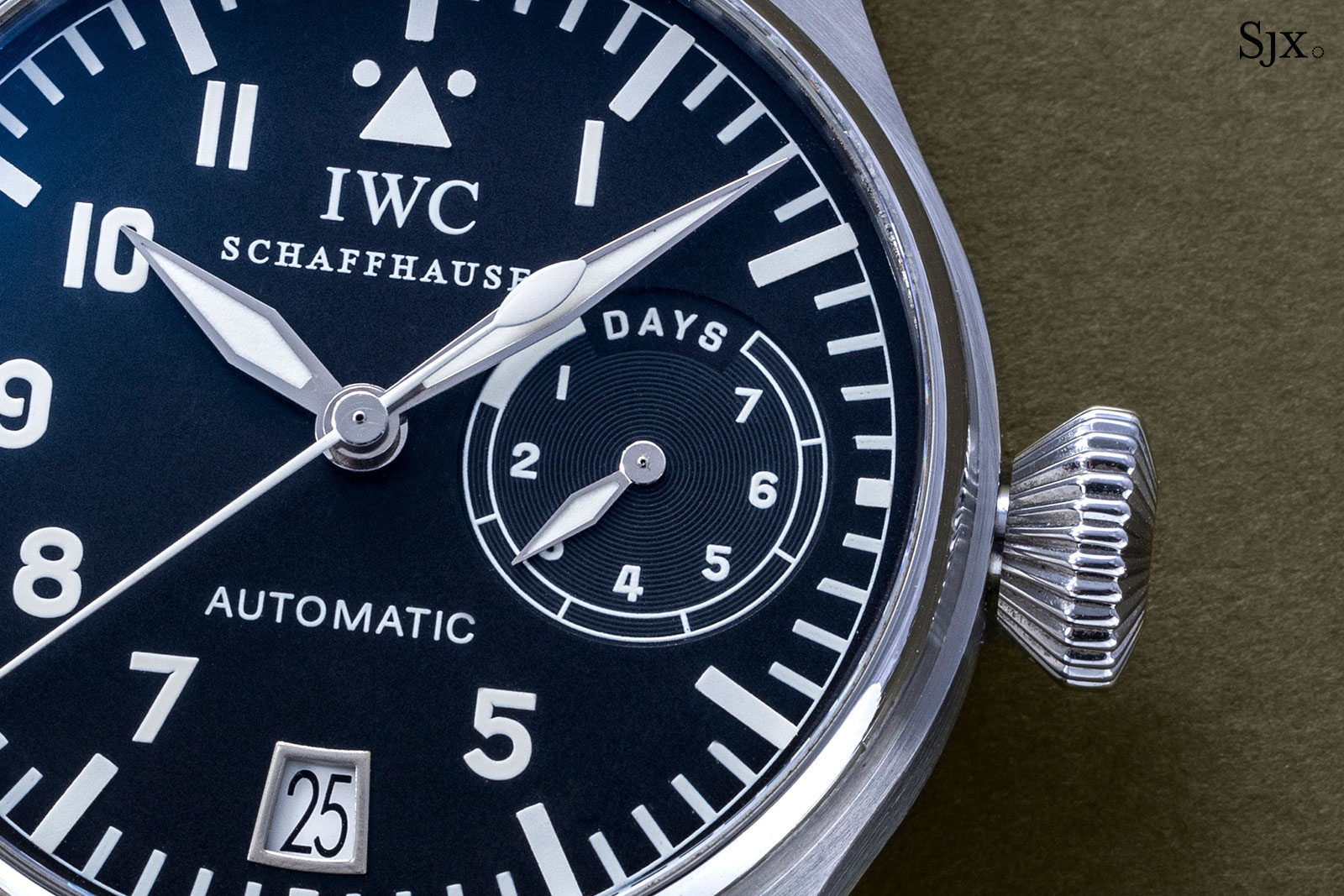
The Big Pilot’s weeklong running time was symbolised by a power-reserve display at three, now a trademark feature of the model
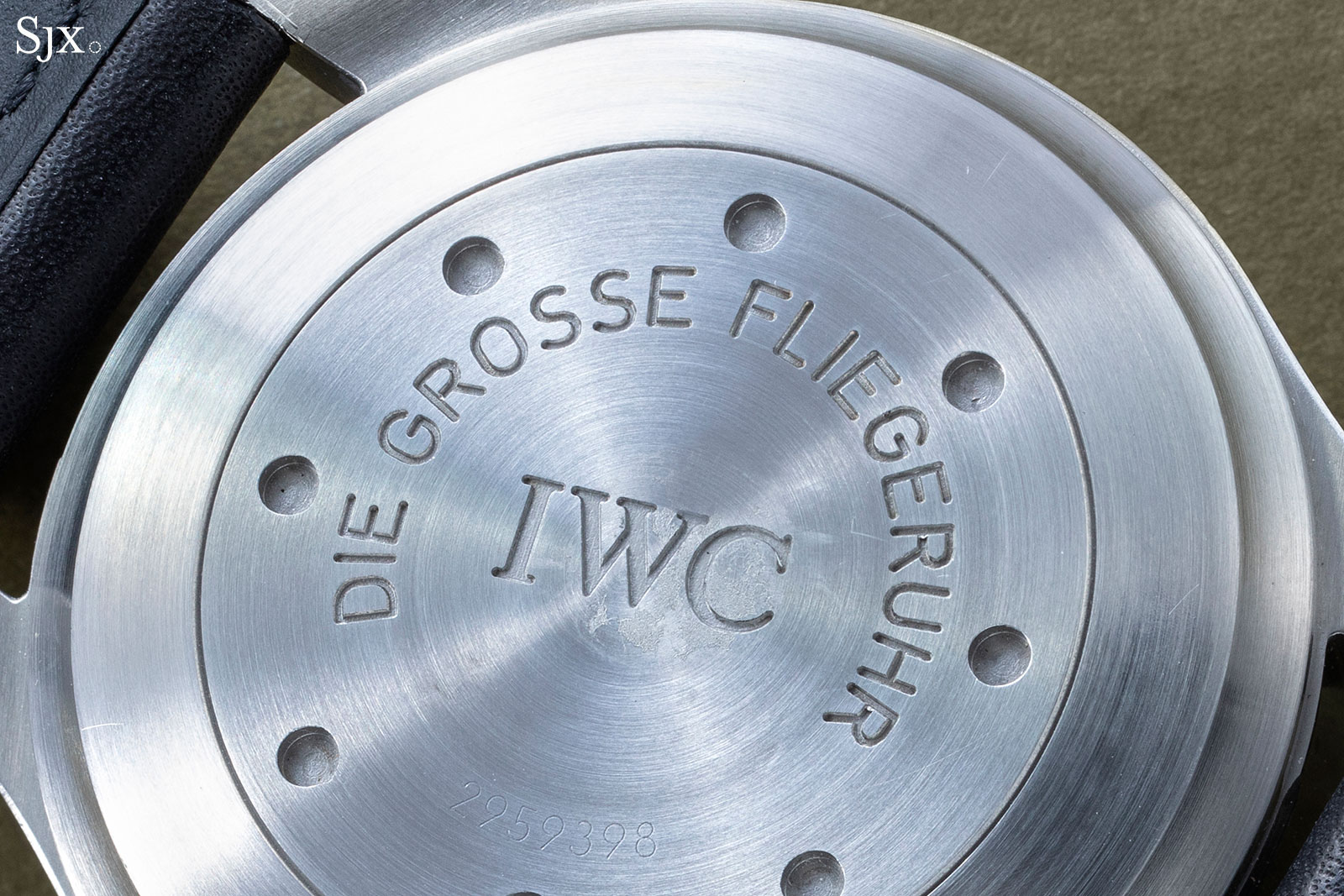
The case back of the ref. 5002
But while the vintage B-uhr was a no-frills instrument issued to pilots, its 21st namesake was a finely constructed and smartly engineered wristwatch.
Smaller than the 55 mm original but still an oversized 46.2 mm, the Big Pilot’s Watch contained the cal. 5001, an in-house movement with a seven-day power reserve. Launched just two years earlier in the Portugieser Automatic 2000, the cal. 5001 was a cutting-edge movement, the first-ever self-winding calibre with a weeklong power reserve.
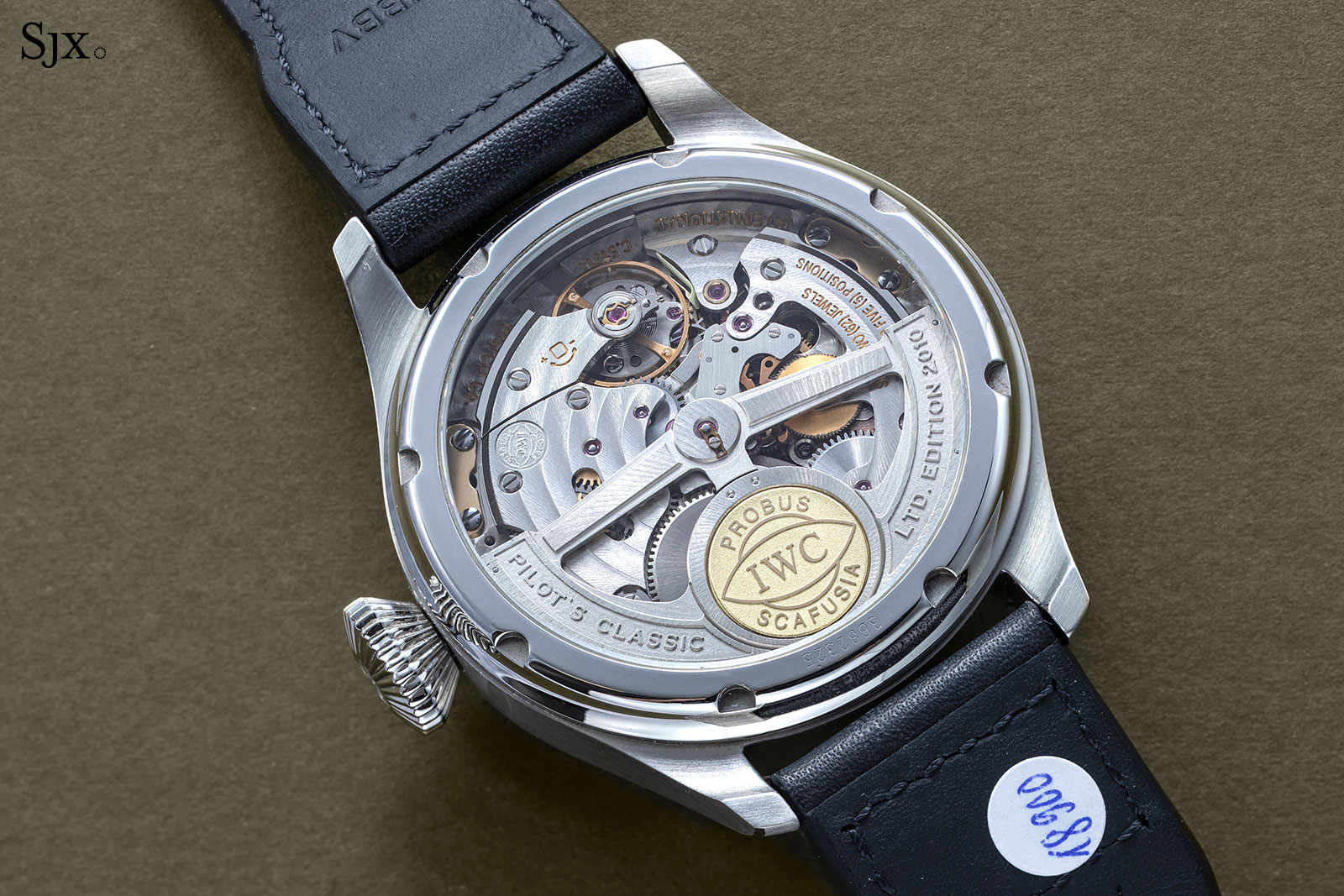
The version of the cal. 5001 in the Big Pilot’s Watch Perpetual Calendar
And like many in-house IWC movements that are automatic, the cal. 5001 featured the Pellaton mechanism, an efficient winding system relying on twin pawls and a winding wheel that was invented in 1950 by Albert Pellaton, the brand’s longtime technical chief.
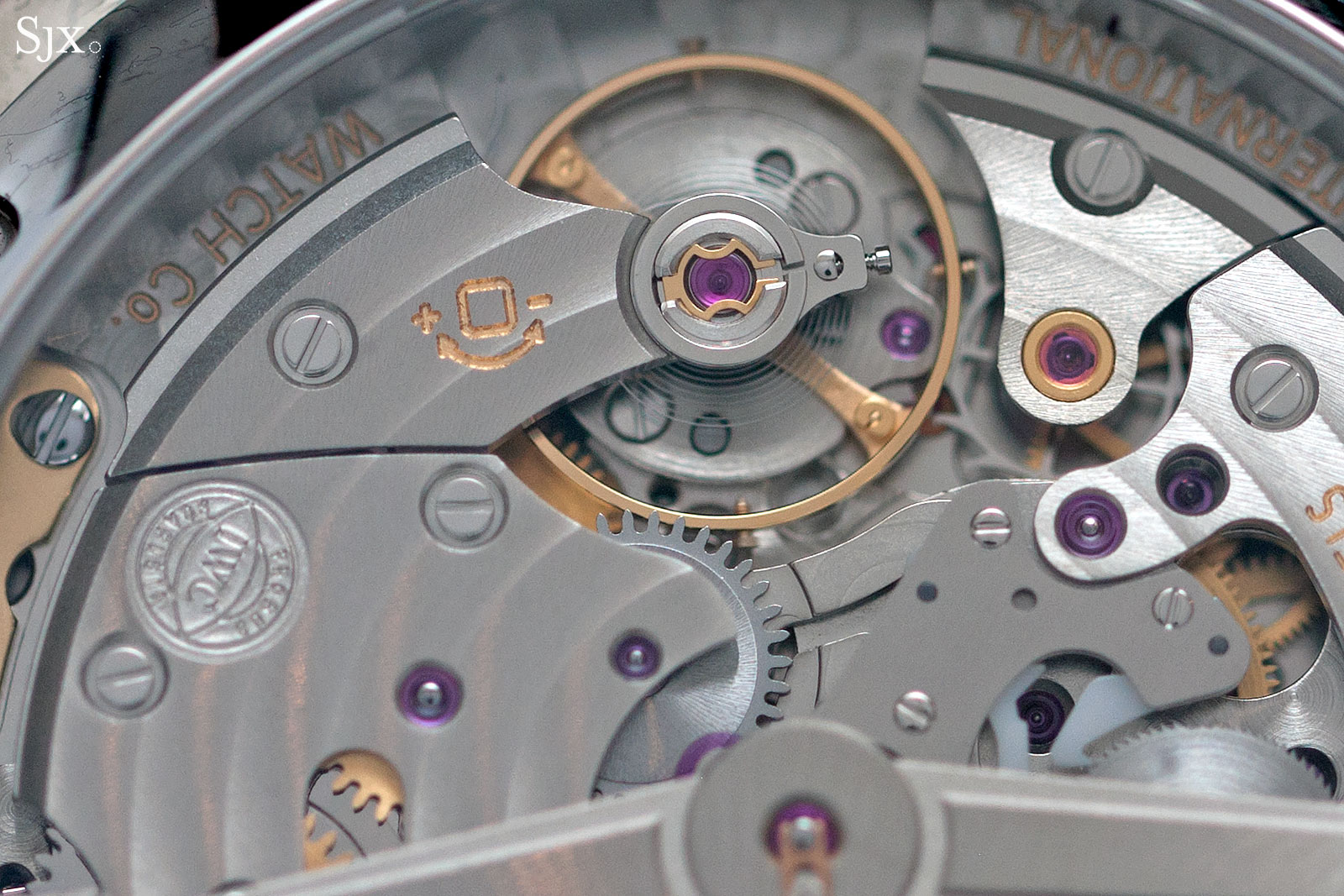
Detail of the cal. 5001, with the twin winding pawls in white ceramic visible at bottom right
All Big Pilot’s Watches since the ref. 5002 have been equipped with IWC’s own movements, setting them apart from the brand’s other Pilot’s Watches, some of which rely on third-party movements.
The major mechanical change to the Big Pilot came in 2016, when the 5000-series movement was progressively phased out in favour of the 52000-series, specifically the cal. 52110. The new movement has all the features of its predecessor, but enhanced with upgrades like winding wheel and pawls of the Pellaton mechanism in wear-resistant ceramic as well as twin barrels for more constant torque over the seven-day running time.
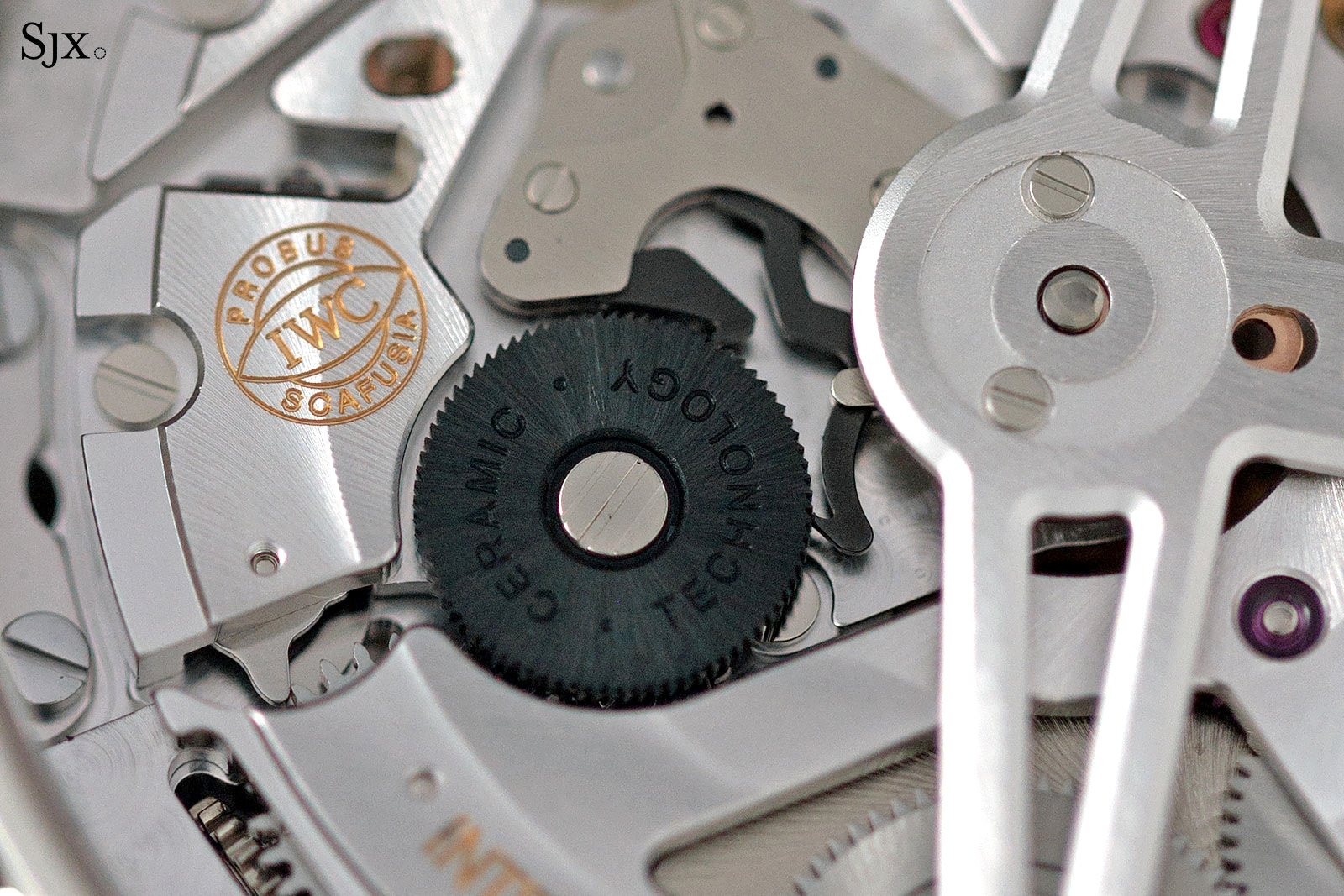
The winding wheel and pawls of the 52000-series movement in black ceramic
Design evolution
Since its introduction in 2002, the Big Pilot has retained the same case with its recognisable proportions of a wide bezel matched with relatively narrow lugs.
But the dial design has been refined since 2002 by softening the military style and making it slightly more elaborate, especially in its precious-metal variants that often have applied hours markers.
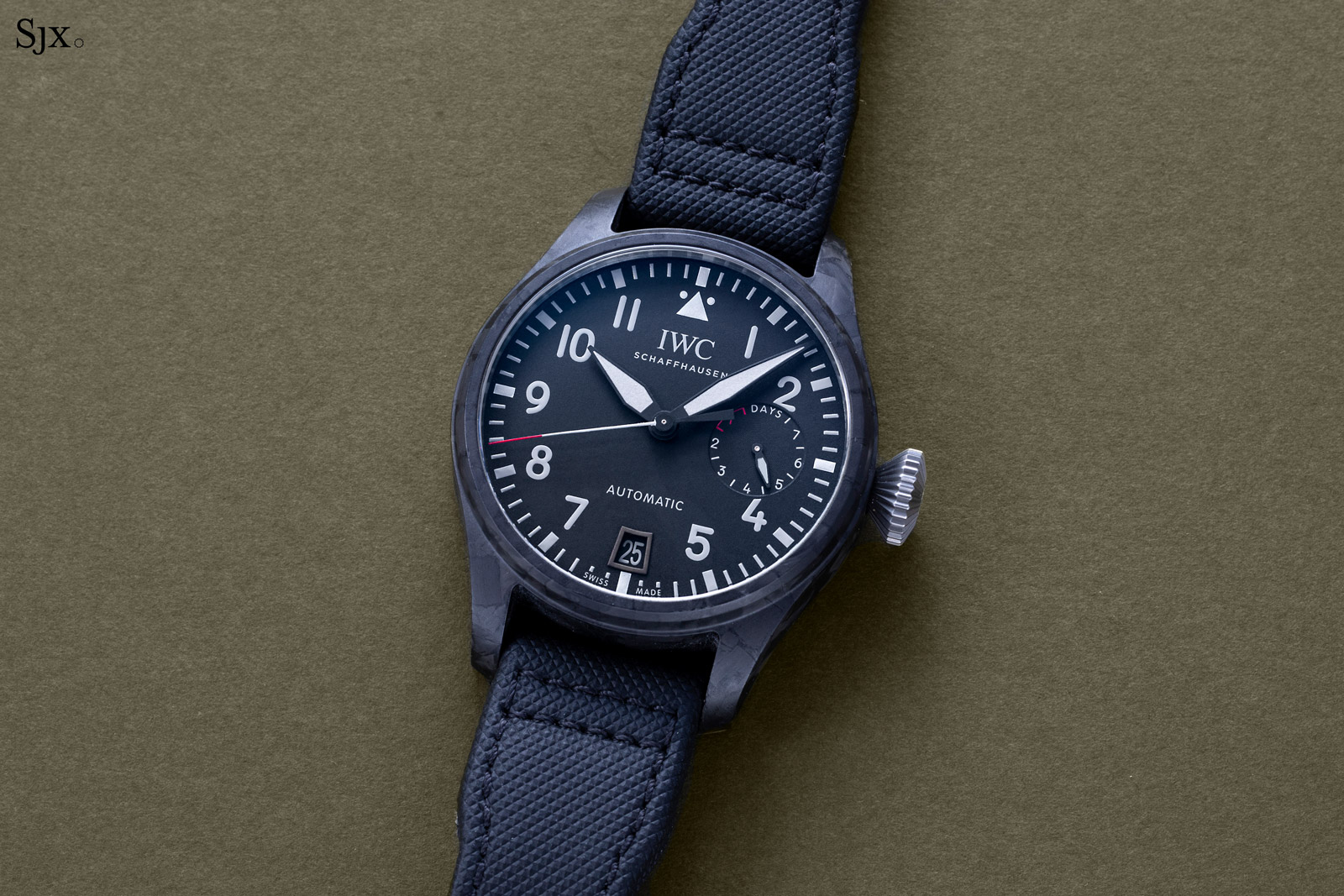
An example of a current-generation Big Pilot’s Watch, the “Black Carbon” limited edition of 2020 that’s powered by the cal. 52010
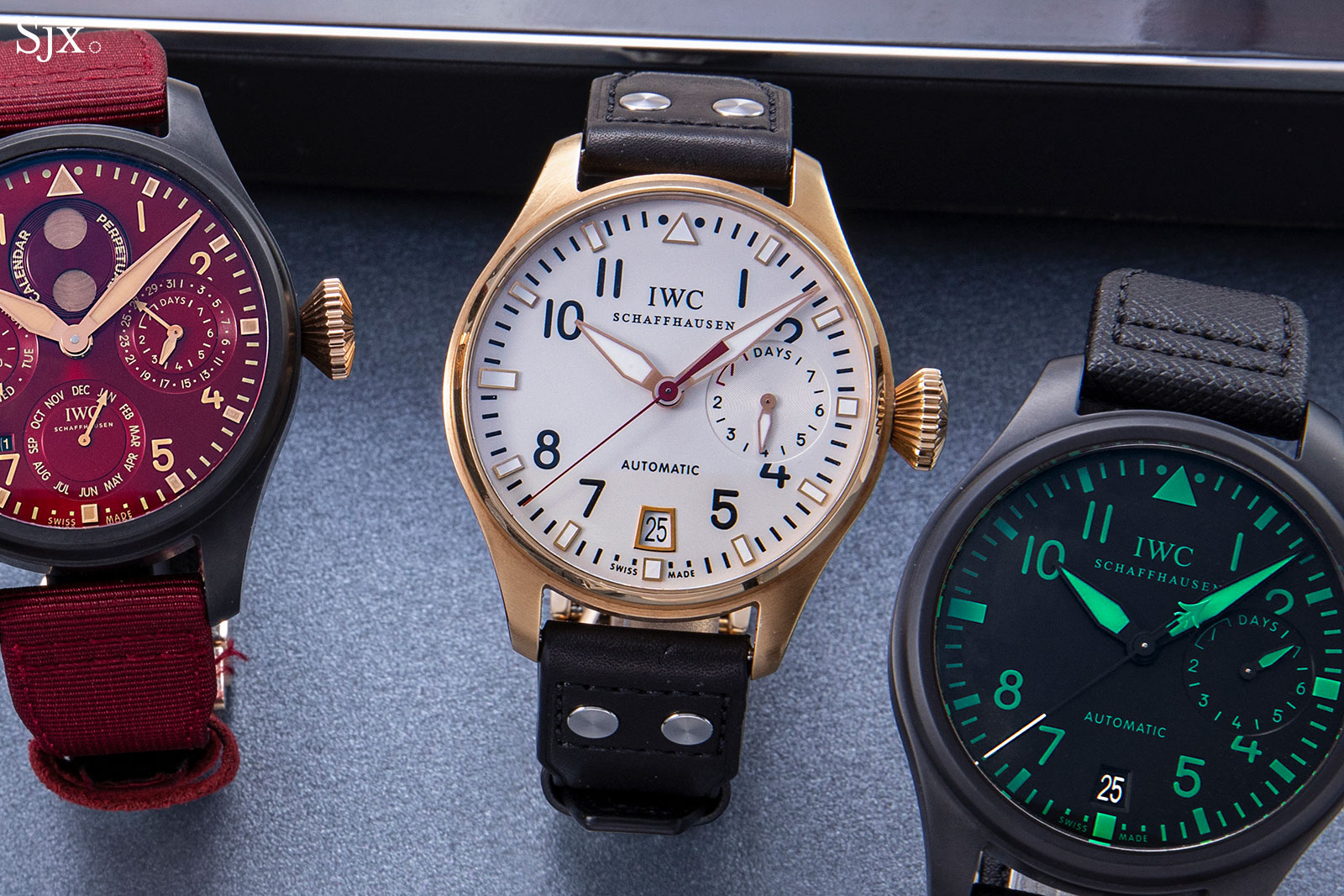
An example of the ref. 5004 with a missing “9”: the Big Pilot’s Watch “Andrea Concato” (centre), a limited edition of 30 made for the eponymous Italian retailer in 2008
While the overarching dial style has been retained, it has been simplified in its details, with shorter hour indices as well as hands and typography with rounded edges.
A key element of the Big Pilot’s design evolution has been its “9”. Like all other IWC Pilot’s Watches of the period, the second-generation Big Pilot’s Watch ref. 5004 was missing the “9” on the dial.
Though the design was met with a mixed reception at launch, it eventually became the de facto look for IWC’s aviator’s watches. But the “9” was eventually restored in 2016 with the replacement ref. 5009. The current crop of Big Pilots (as well as Pilot’s Watches) all feature a full suite of hour numerals.
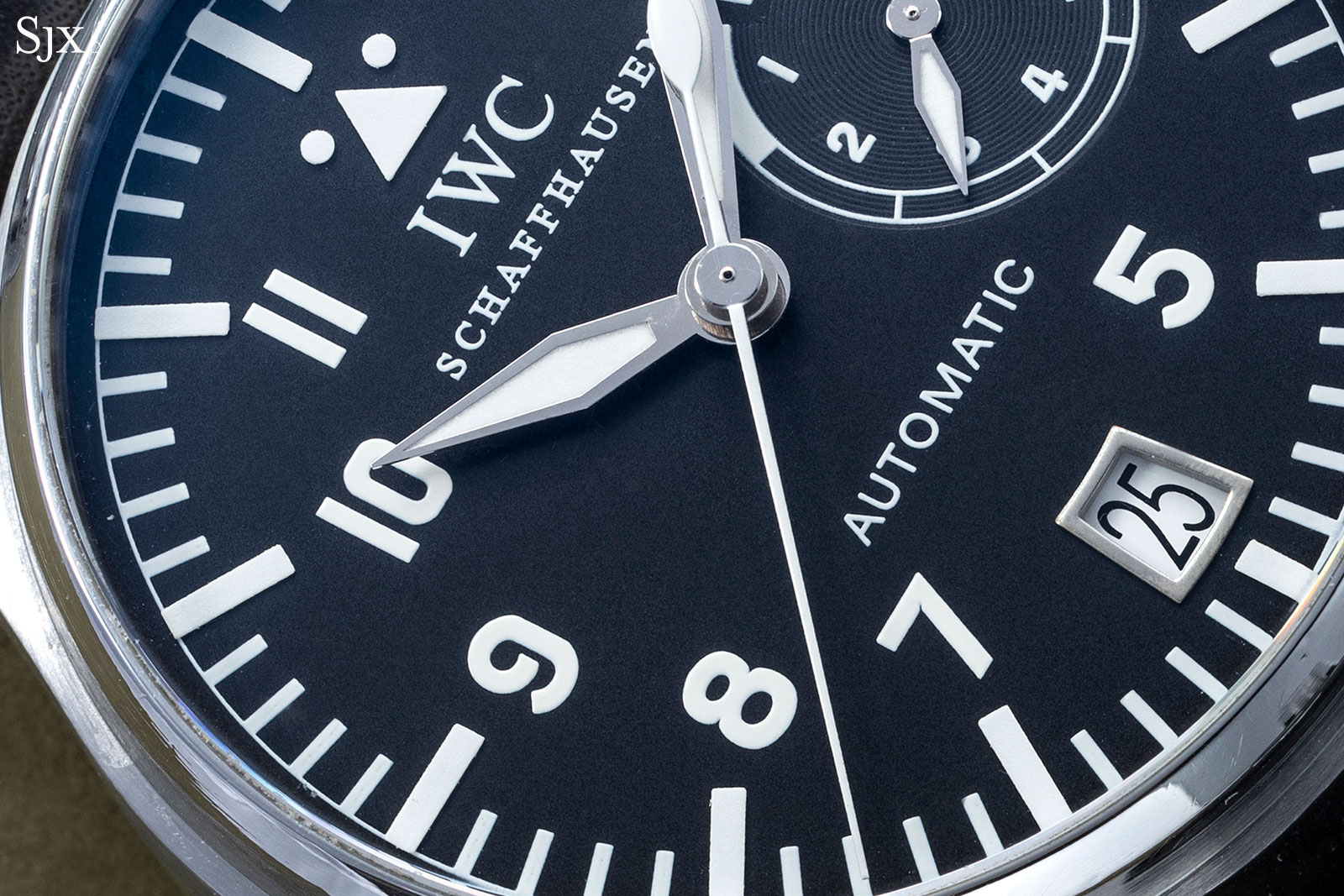
The ref. 5002 with its formal, angular details that echo the vintage original
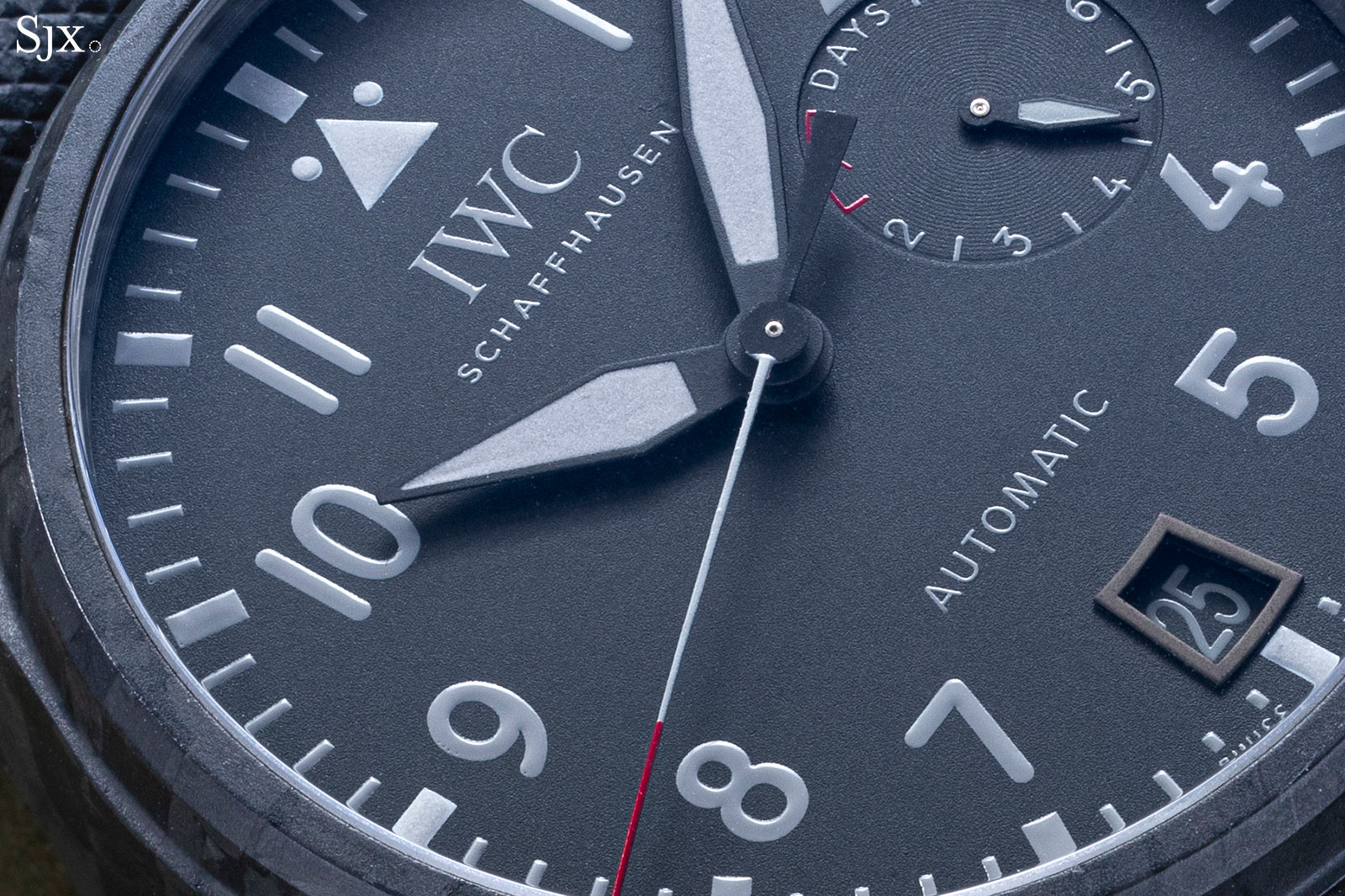
And today’s Big Pilot with its more approachable details
Earlier this year at Watches & Wonders, IWC unveiled the surprising Big Pilot’s Watch 43 – paradoxically the smallest Big Pilot to date. It is an evolution that has polarised opinions.
On the one hand, it is rightly lauded for improved wearability – it looks like a Big Pilot but wears like a more conventional wristwatch – but it has been criticised for deviating from the extra-large size that defines the model.
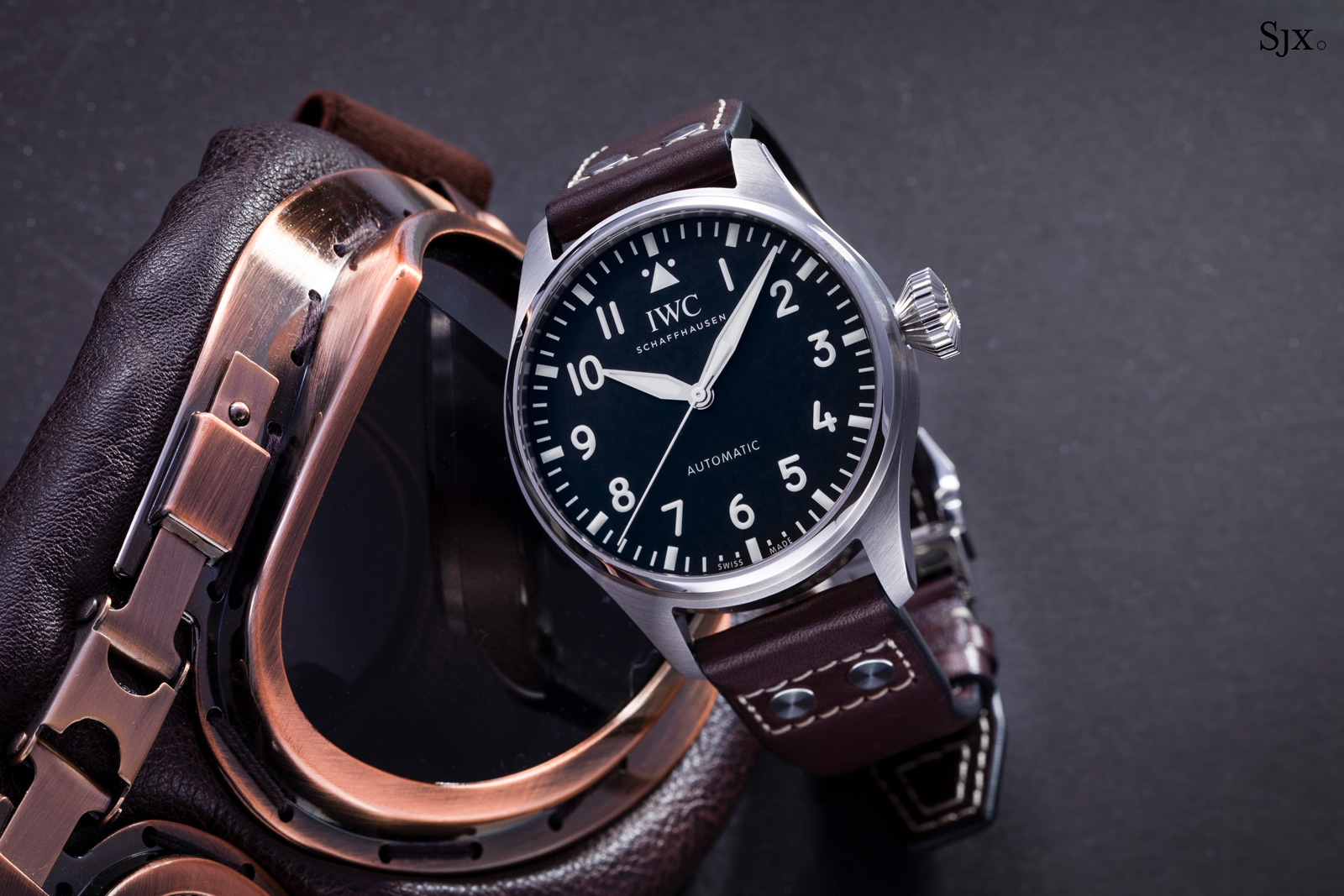
The smaller Big Pilot
But at heart, the 43 mm Big Pilot remains true to the model name, at least in a technical sense. It is equipped with the in-house the cal. 82100 that has a 60-hour power reserve. But like its bigger brother, the cal. 52110, the cal. 82100 has the components of its winding mechanism in ceramic. And purists will certainly appreciate the fact that the Big Pilot 43 has no date display.
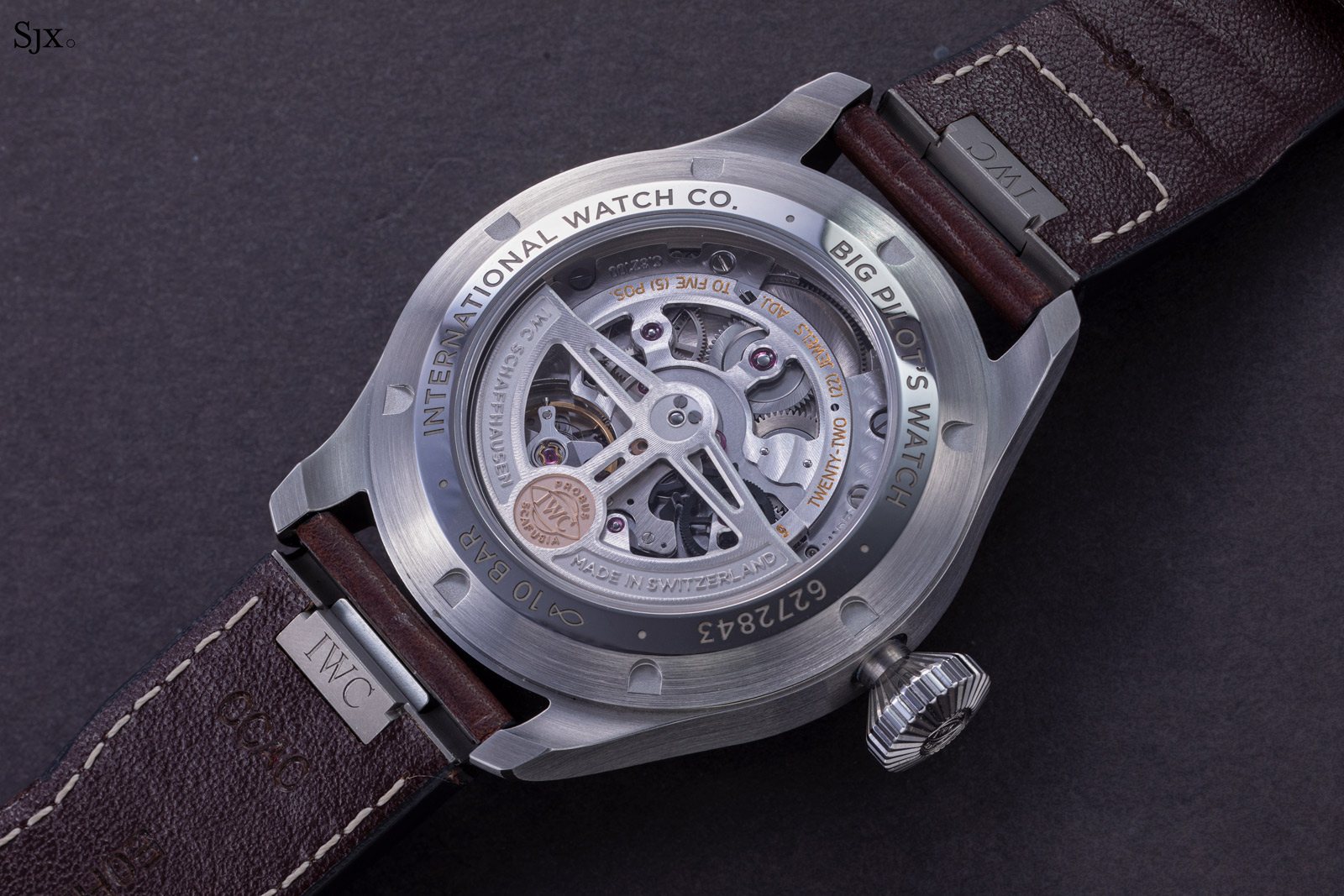
The cal. 82100
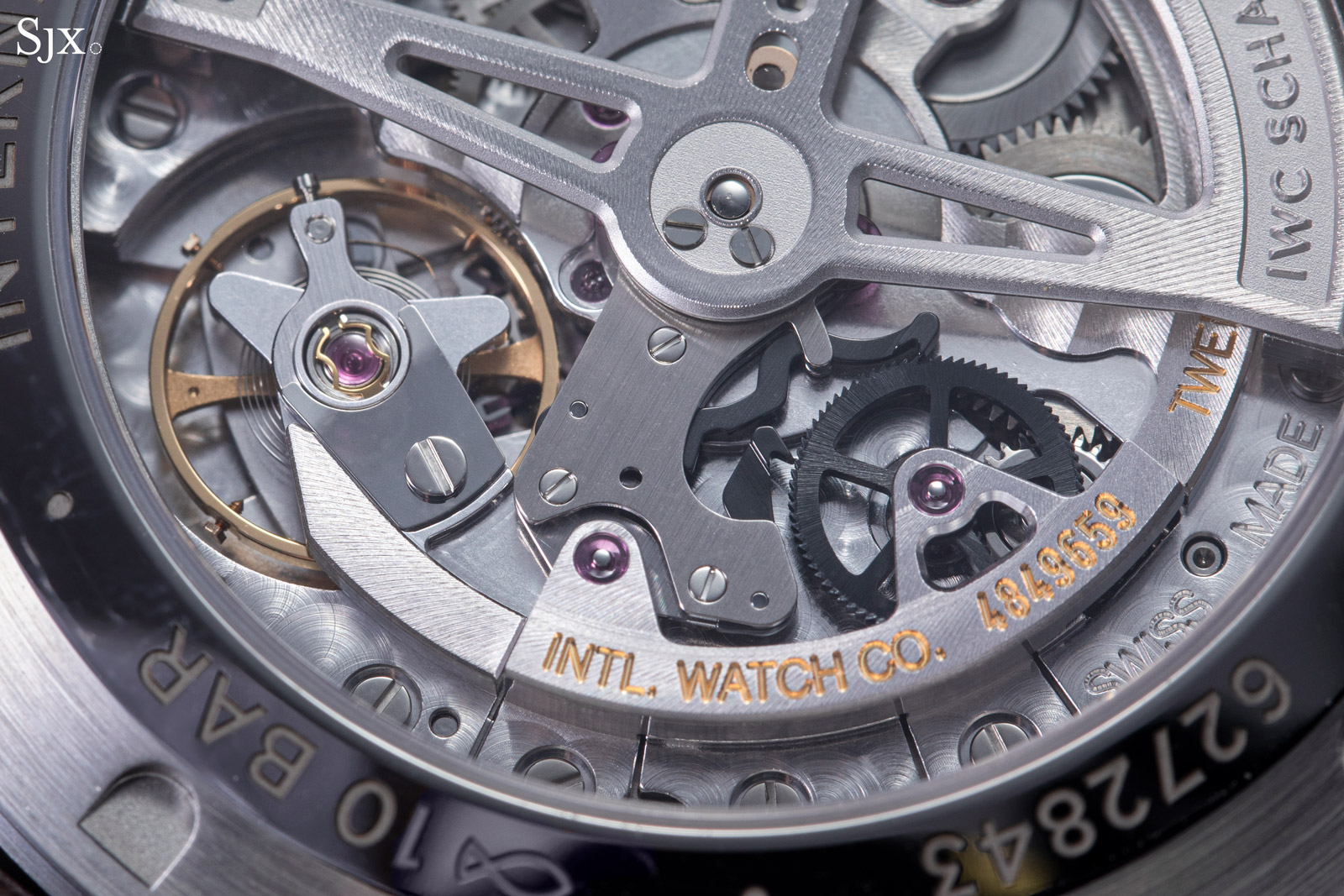
The ceramic parts of the Pellaton winding mechanism
And the complications
In its two decades, the Big Pilot has also played host to a range of complications, including the top-of-the-line Big Pilot’s Watch Constant-Force Tourbillon. But the defining complication of the range has always been the perpetual calendar, first introduced in 2006 as a limited edition for two retailers, Cellini in New York and Sincere in Singapore.
While a perpetual calendar on a pilot’s watch might seem incongruous, the Big Pilot perpetual joins two concepts that are quintessentially IWC.
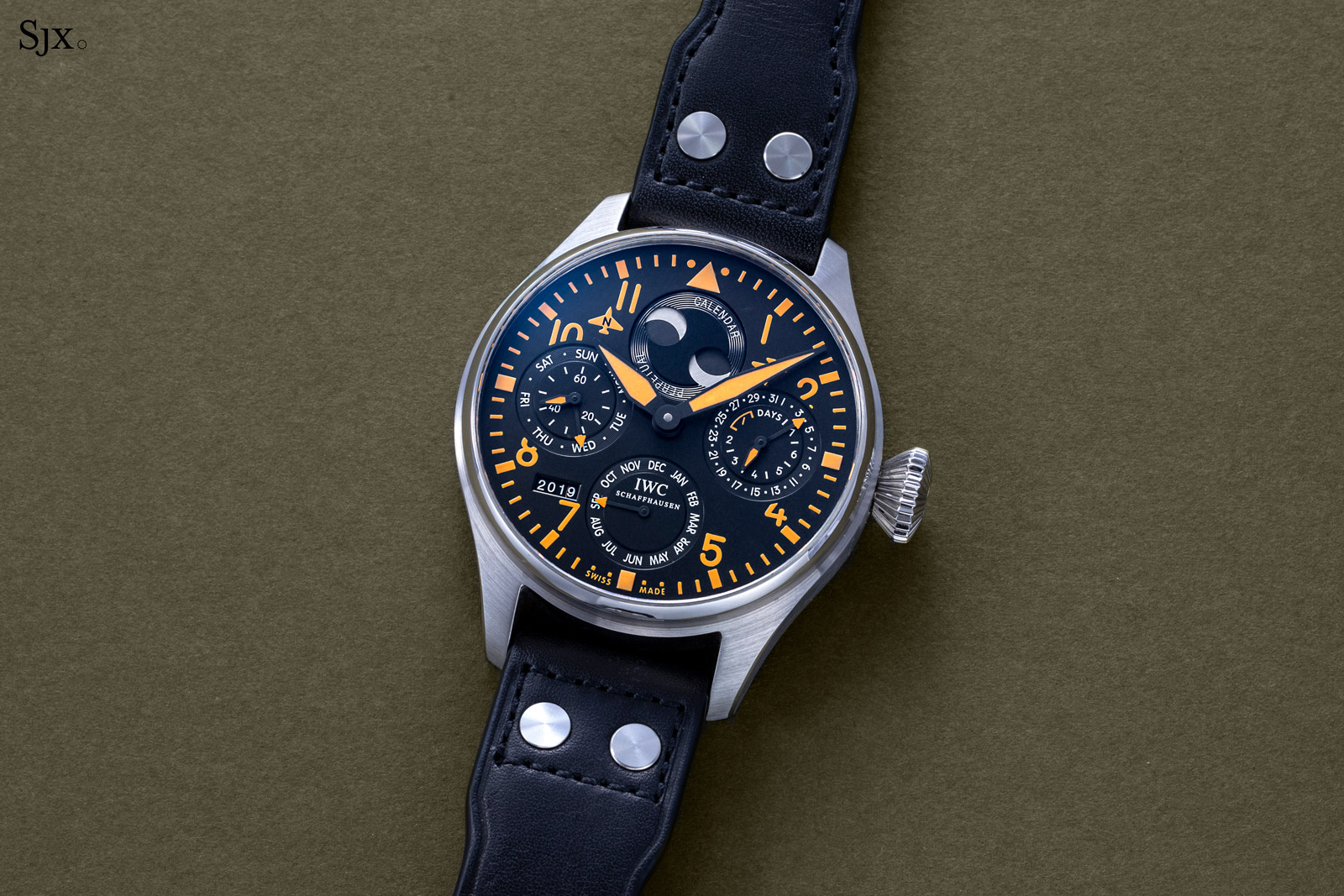
The ref. IW502618 with twin aircraft emblems that indicate north and southern hemispheres for the moon phase
Perhaps the IWC complication, the perpetual calendar mechanism was invented in 1985 by the venerable Kurt Klaus – who joined the brand in 1957 and remains active today as an IWC ambassador – and appears conventional on its face.
Debuted as part of the Da Vinci 3750, the calendar is indicated with four sub-dials and double-hemisphere moon display, along with its distinguishing feature, the four-digit year display.
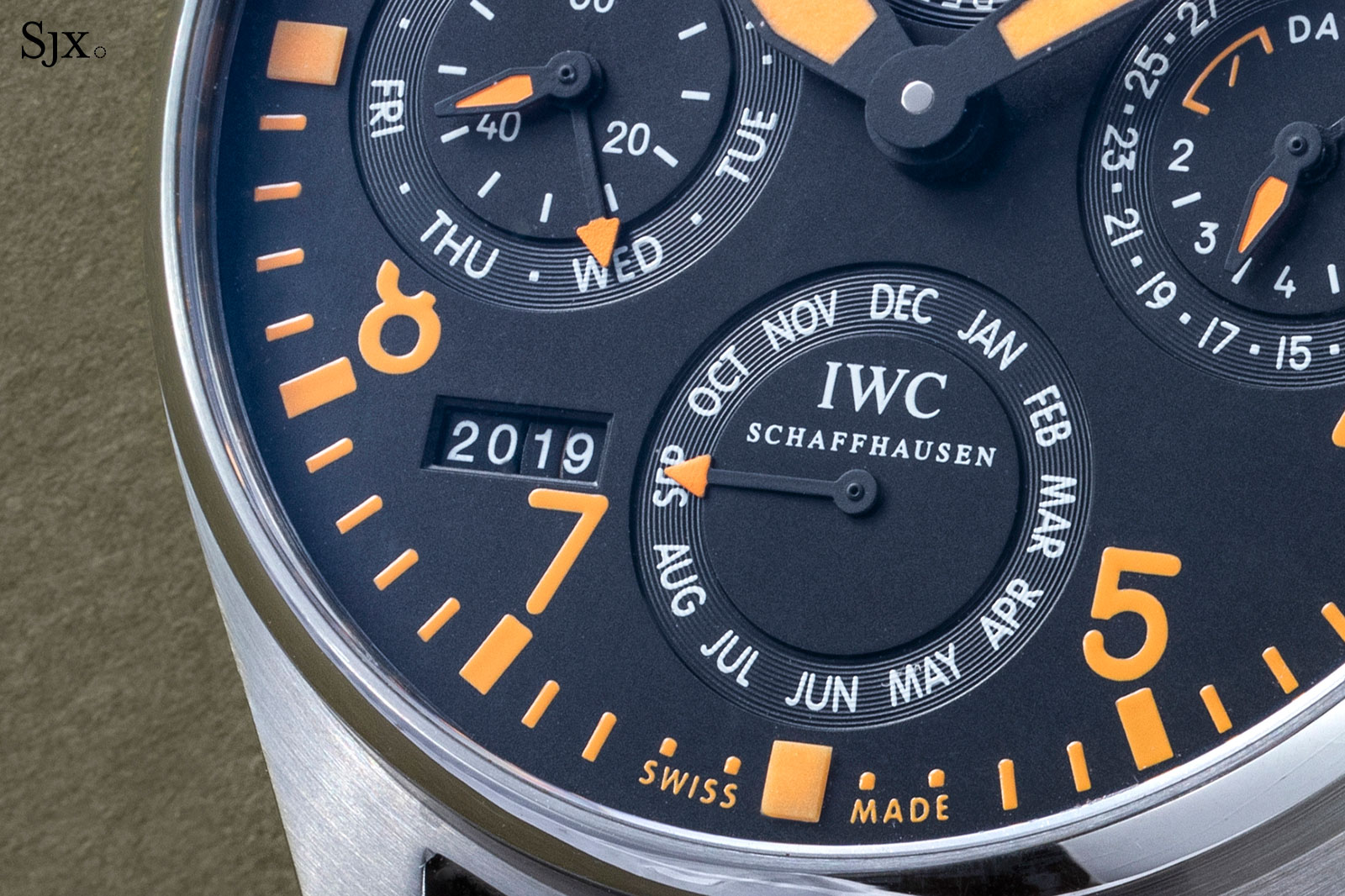
In the Big Pilot (as well as the Portugieser), the perpetual calendar mechanism is enhanced with a seven-day power reserve, an especially useful feature for a calendar watch.
And from a readability perspective, the perpetual calendar makes sense on the Big Pilot, since the extra-large dial means enough real estate for legibility calendar indications. At the same time, the sub-dials fill up the wide dial, resulting in a look that calls to mind an aircraft instrument panel.
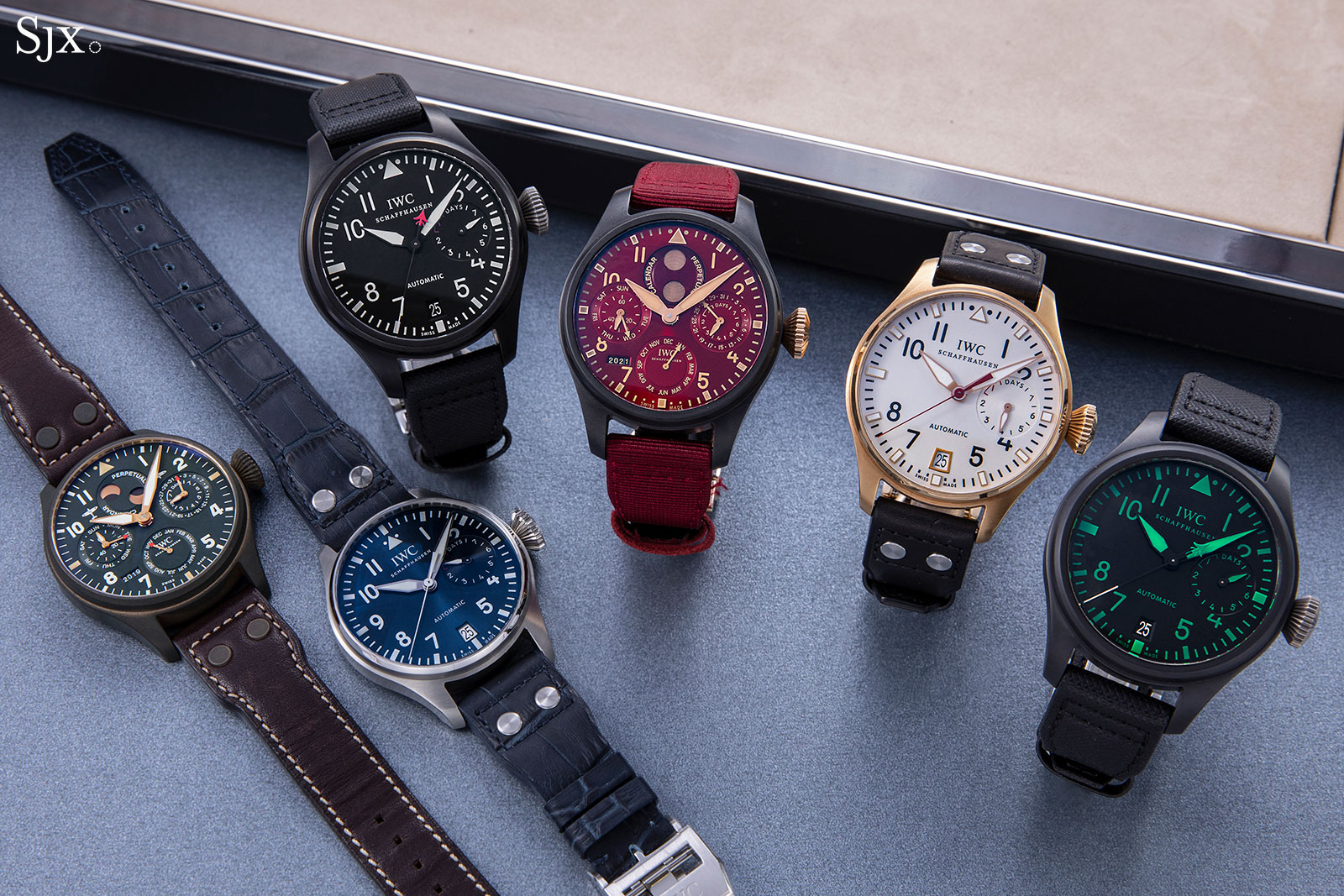
The Big Pilot Exhibition
Charting the development of the Big Pilot’s Watch, thirty-one examples of the model, including the inaugural ref. 5002 as well as the rare “Markus Bühler” will be on show in Singapore from September 9-12.
Entry to the exhibition is free, but registration is required on IWC.com.
Update September 7, 2021: Registration is closed as the exhibition has reached the maximum capacity allowed by government guidelines, as a result walk-in visitors cannot be admitted.
This was brought to you in collaboration with IWC.
Back to top.
